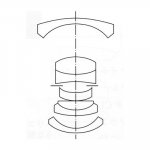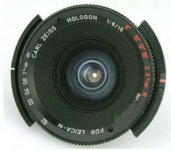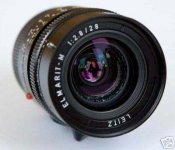The white spots that are so common are signs that the balsam glue in the lens is deterioating. As long as it stays on the black mount part, there is no visible problem with using it, but it also weakens the lens. A sharp rap on the lens can get it to come apart. It is quite common with older lenses (I had a Hologon 15f8 where this was a problem!). It can be fixed, but it is fairly costly to do so.
My biggest problem with the Rokkor 28 was the fact that the hood always came off!
The performance of the Rokkor is good, but I think you are better off with a used Elmarit 28f2.8 (preferably a post 1980 lens). The other alternative is a Voigtlander 28f3.5, which although a bit slower, is a better performer. It is out of production now, but Camerquest or Photovilla might still have stock.
The Rokkor was very compact and if that is a point for you, the VC 28 is about the same size. The Elmarit 28 is a bigger lens and due to the M8 it has become more expensive used and a bit difficult to find.




